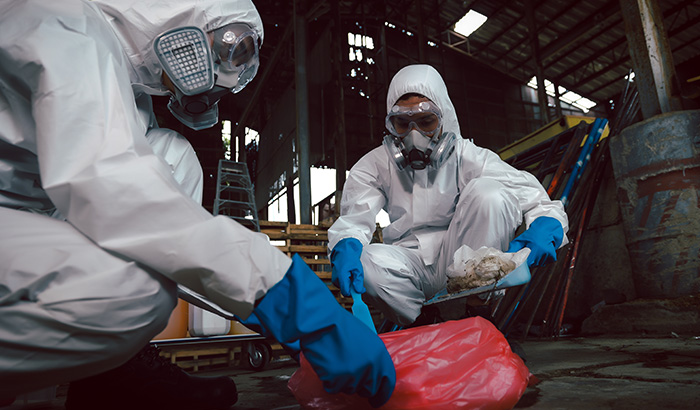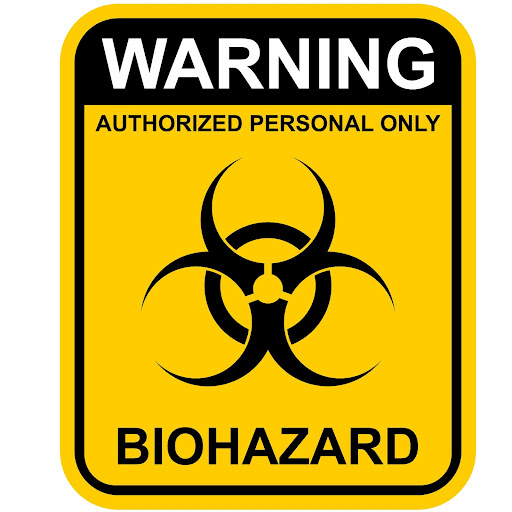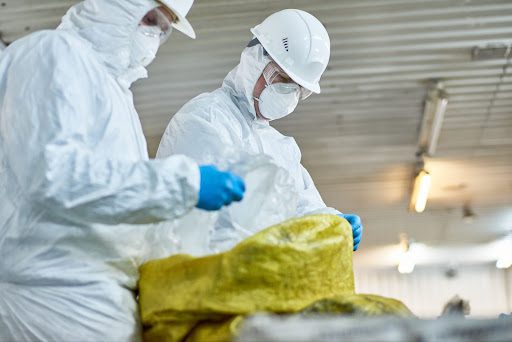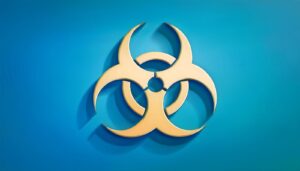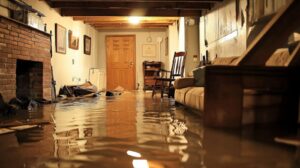Biohazard clean-up is a critical service performed by a restoration company. It plays a significant role in protecting public health and safety. From preventing the spread of infectious diseases to safeguarding the well-being of individuals and communities, biohazard clean-up professionals contribute to maintaining cleanliness and hygiene standards in various settings.
Whether you are a biohazard clean-up professional or someone seeking to understand the importance of this service, this guide will provide valuable insights into the vital role biohazard clean-up plays in ensuring public health and safety.
What Is a Biohazard?
A biohazard is any biological or chemical substance that can harm human, animal, or environmental health. These hazardous substances include viruses, bacteria, fungi, toxins, and chemical and radiological materials.
It’s imperative to recognize the potential dangers of these substances when they are released into the environment, as they can cause severe health effects and potentially spread diseases.
Different Types of Biohazards
Biohazards can be categorized into several distinct types:
- Infectious agents: This category includes bacteria, viruses, fungi, and parasites that can cause various illnesses including hepatitis, HIV, tuberculosis, and other dangerous infections.
- Medical waste: Within medical facilities, you’ll deal with needles, syringes, and surgical instruments. Proper disposal and management of these tools are crucial to prevent the spread of diseases.
- Chemicals: Biohazardous chemicals can include toxic substances utilized in medical and industrial processes and those released during natural disasters such as floods or wildfires. These chemicals can pose significant health risks if not handled and removed properly.
- Biologically or chemically contaminated environments: There might be biohazards in or around illicit drug labs, illegal dumping sites, or crime scenes. These environments require specialized attention to ensure safe removal and remediation of the contamination.
What Are Biohazard Clean Up Services?
The primary role of a restoration company’s biohazard clean-up services is to provide professional, comprehensive removal of hazardous biological, chemical, and radiological materials from contaminated areas. These services play a critical role in preventing the spread of diseases and ensuring the safety of individuals, animals, and the environment.
Biohazard clean up professionals possess specialized training, expertise, and equipment necessary to safely handle, remove, and dispose of hazardous materials in compliance with stringent regulatory guidelines.
By effectively managing and eliminating biohazardous substances, these professionals contribute to safeguarding the well-being of communities and mitigating potential harm caused by exposure to biohazards.
Training and Certification for Biohazard Clean Up Professionals
It is essential for biohazard cleanup professionals to undergo specialized training and obtain appropriate certifications for several reasons.
Firstly, biohazard clean up involves handling hazardous materials that can pose significant health risks if not managed properly. Specialized training ensures that professionals have the knowledge and skills to protect themselves and others from potential harm.
Biohazard cleanup professionals require a range of skills and knowledge to carry out their duties effectively. These include:
- Hazard recognition and assessment: Professionals need to be able to identify and assess different types of biohazards, their potential risks, and appropriate methods for containment and removal.
- Personal protective equipment (PPE) usage: Proper selection and use of PPE, including gloves, masks, goggles, and protective suits, is crucial to prevent exposure and contamination.
- Decontamination techniques: Professionals must be knowledgeable in applying effective cleaning and disinfection techniques to eliminate biohazards and minimize the risk of infection or contamination.
- Waste disposal regulations: Understanding local and federal regulations for biohazardous waste disposal is essential to ensure compliance and proper containment and transport of hazardous materials.
- Communication and empathy: Professionals often work in sensitive and emotionally charged situations. Strong communication and empathy skills are necessary to effectively interact with clients, stakeholders, and individuals impacted by the biohazard.
Biohazard clean up professionals should continually update their knowledge and skills through ongoing training and education to stay up-to-date with advances in the field and regulatory requirements. This ensures that they can provide the highest level of service and maintain the safety and well-being of all involved parties.
Safety Procedures and Equipment Used in Biohazard Clean Up
Biohazard clean up involves strict adherence to safety procedures and protocols to minimize the risk of exposure to hazardous substances, one of which is containment.
When confronted with a biohazard, the first step in containment is to establish a perimeter or barrier around the affected area to restrict access and prevent contamination. This can be achieved by using caution tape, barricades, or other physical barriers.
Next, identifying and implementing appropriate safety measures, including donning PPE, is essential. These protective measures serve to shield individuals from direct contact with the biohazardous material and lower the risk of exposure.
Furthermore, it is crucial to properly handle and contain the biohazardous material. Carefully place any contaminated objects or substances into leak-proof and appropriately labeled biohazard bags or containers.
These containers should be durable, sealable, and puncture-resistant to prevent leakage and minimize the risk of accidental exposure. If necessary, use absorbent material to collect any spilled or excess material, and promptly dispose of it in accordance with local regulations and guidelines.
Additionally, it may be necessary to implement engineering controls to further contain the biohazard. This could include using plastic sheeting or barriers to isolate the affected area and creating a controlled environment that limits the spread of pathogens. Ventilation systems should also be considered to control and monitor airflow, ensuring that any airborne contaminants are properly contained.
Disinfection is a critical step in biohazard clean up. It ensures the complete elimination of pathogens and contaminants. Techniques and products used include:
- Cleaning agents: A variety of cleaning agents and solutions are used to disinfect surfaces and equipment. These may include bleach, hydrogen peroxide, quaternary ammonium compounds, and hospital-grade disinfectants.
- Application methods: Use spraying, wiping, or misting techniques to apply disinfectants to surfaces, ensuring thorough coverage and contact time necessary for effective disinfection.
- Specialized equipment: Biohazard cleanup professionals may utilize specialized equipment such as foggers or electrostatic sprayers to ensure even distribution of disinfectants and to reach challenging areas.
It is important to note that the specific disinfection techniques and products used may vary depending on the type of biohazard and the regulations and guidelines in place. Biohazard cleanup professionals stay updated on the latest disinfection practices and use appropriate techniques and products to achieve effective decontamination.
Legal Considerations and Regulations
Biohazard clean up services are subject to various laws and regulations, which may vary depending on the jurisdiction. Some common legal considerations include:
- Occupational safety and health regulations: Professionals must comply with workplace safety regulations that aim to protect workers from hazards, such as bloodborne pathogens and hazardous waste.
- Environmental regulations: The disposal of biohazardous waste is subject to specific regulations to safeguard the environment and prevent contamination.
- Transporting hazardous materials: Compliance with these regulations ensures the safe transport and containment of biohazardous substances during transportation.
- Other regulatory bodies: Apart from OSHA, other regulatory bodies such as state health departments, the Environmental Protection Agency (EPA), and local health departments may impose specific requirements on biohazard clean up services.
OSHA is a central regulatory body in the United States responsible for establishing and enforcing workplace safety standards. Compliance with OSHA standards is crucial for biohazard clean up professionals and typically involves:
- bloodborne Pathogens Standard: This standard mandates the development of exposure control plans, employee training, and the use of appropriate PPE to protect workers from bloodborne pathogens such as HIV, hepatitis B, and hepatitis C.
- Hazard Communication Standard: This standard requires employers to communicate the hazards associated with chemicals used in biohazard clean up to employees, including proper labeling, safety data sheets, and employee training.
- Personal protective equipment (PPE): OSHA mandates that employers provide appropriate PPE and ensure its proper usage and maintenance by employees.
- Record-keeping and reporting: Certain biohazard incidents may need documentation and reported to OSHA as part of their record-keeping requirements.
Compliance with OSHA standards ensures workers’ safety and well-being and helps avoid penalties and legal consequences for non-compliance.
Importance of Biohazard Clean Up for Public Health and Safety
Biohazard clean up plays a crucial role in preventing the spread of infectious diseases in various ways:
- Contaminated surfaces and materials: Biohazardous materials, like blood, bodily fluids, and other potentially infectious substances, can harbor pathogens that may remain viable for a long time. Properly cleaning and disinfecting these surfaces and materials help eliminate pathogens, reducing the risk of transmission.
- Elimination of potential breeding grounds: Areas contaminated by biohazards can create an environment conducive to the growth and proliferation of disease-causing microorganisms. Biohazard clean up removes these potential breeding grounds, minimizing the risk of disease transmission.
- Preventing cross-contamination: Properly handling, containing, and disposing of biohazardous waste prevents cross-contamination between different areas or individuals. This is particularly important in healthcare settings, where patients with compromised immune systems may be highly susceptible to infections.
Biohazard clean up directly contributes to the well-being of individuals and communities by:
- Protecting workers and responders: Biohazard clean up professionals are trained to work safely and effectively in hazardous environments. By following proper safety protocols and using appropriate PPE, they minimize their risk of exposure to biohazards.
- Mitigating health risks: Thorough biohazard clean up reduces the risk of exposure to harmful microorganisms, toxins, and hazardous substances. This is particularly important for vulnerable populations such as children, the elderly, and individuals with compromised immune systems.
- Restoring psychological well-being: The aftermath of a biohazard incident can have a significant psychological impact on individuals and communities. Proper biohazard clean up helps restore a sense of safety and security, alleviating anxiety and promoting overall well-being.
Biohazard clean-up is vital in preventing the spread of infectious diseases, safeguarding the well-being of individuals and communities, and maintaining cleanliness and hygiene standards. It is an essential service that contributes to public health and safety in numerous settings.
Call Total Flood and Fire Restoration Today
If you are dealing with a biohazard, you need a restoration company. Total Flood and Fire Restoration is here to perform the biohazard clean up services you need to get your life back to normal. Call us at 385.503.2572, or contact us through our website to schedule your appointment today!

